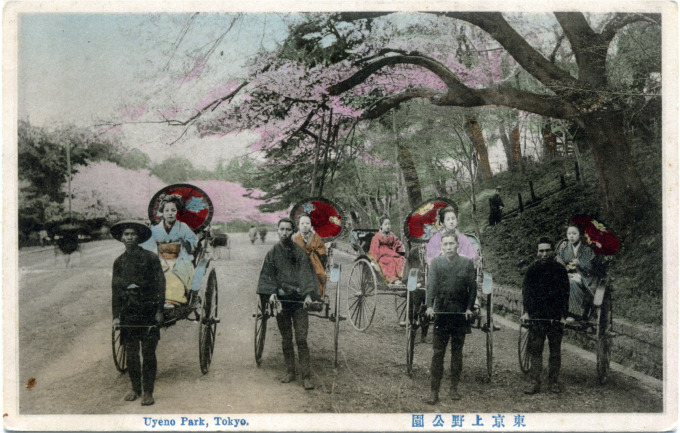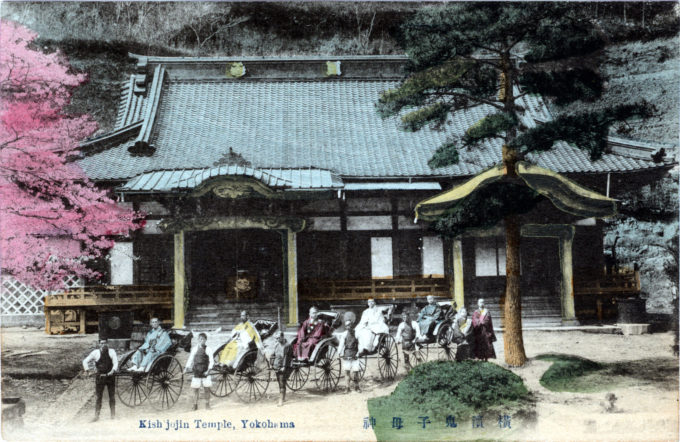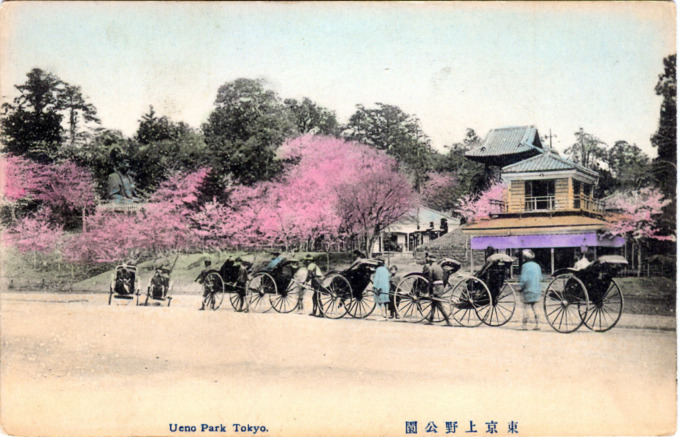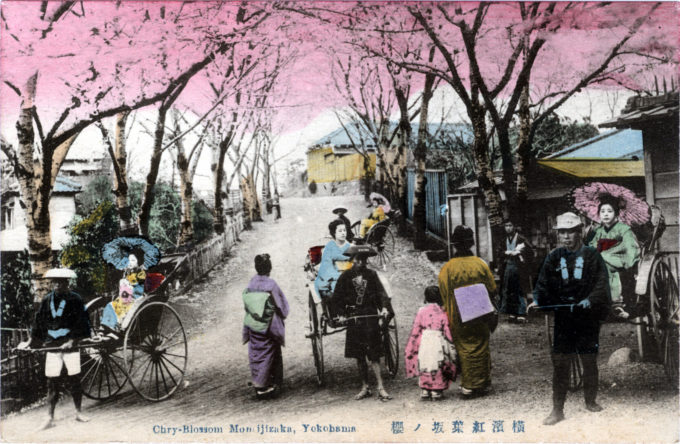See also:
“If you experiment with the jinrikisha on a level road, you will find that it is only the first pull that is hard; once started the little carriage seems to run by itself. The gait of the man, and his height, determine the comfort of the ride. A tall coolie holds the shafts too high, and tilts one at an uncomfortable angle; a very short man makes the best runner, and, with big toe curling upward, will trot along as regularly as a horse. As one looks down upon the bobbing creature below a hat and two feet seem to constitute the whole motor.”
– Jinrikisha Days in Japan, Eliza Ruhamah Scidmore, 1891.
“In 1870, the jinrikisha appeared which had a revolutionary impact on Meiji Japan. As this ‘Japanese’ invention is of pivotal importance to the modernization and incorporation process it is pertinent to elaborate aspects of the production of this two wheel vehicle for the conveyance of one or two passengers pulled by a man. The Emperor Meiji had no doubts about its revolutionary potential as he made a series of peregrinations between 1872 and 1875 to promote its diffusion on both short and long distance routes.
“On shorter journeys fare schedules showed it was cheaper than the palaquin (kago) and on longer journeys, such as that between Tokyo and Sendai (368km) it had no peer. Judging by the rapid adoption of the jinrikisha throughout Japan; its widespread production, the number of inns offering hire services and its early export, the Emperor Meiji had been most successful in his promotional activities.
“… An examination of two firms – Akiba Shoten of Ginza, Tokyo, and Ito Shoten of Osaka – shows that the jinrikisha was, in some respects, a forerunner of Japan’s modern industrialization and export success … A wide export market was developed for the jinrikisha. By 1877 the jinrikisha was already operating in Shanghai. Seven years later they were exported to Hong Kong, India and Singapore. Details of the jinrikisha exports for the late Meiji [period] shows that by then the prime markets were India, China, Hong Kong, the English colonies (presumably Singapore) and, to a lesser extent, Korea, the Philippines, the French colonies (presumably those in India and Vietnam), Thailand and Indonesia. There were even small sales to Europe, North America, Africa and Australia.”
– Rikisha to Rapid Transit: Urban Public Transport System and Policy in Southeast Asia, by Peter Rimmer, 1986
“Starting in 1870, the Tokyo government issued permission for Izumi Yosuke, Takayama Kosuke, and Suzuki Tokujiro to build and sell rickshaws. [Jinrikisha translates literally from the Japanese to ‘human power vehicle’.] By 1872, they became the main mode of transportation in Japan, with about 40,000 rickshaws in service.
“The rickshaw’s popularity in Japan declined by the 1930s with the advent of automated forms of transportation, like automobiles and trains. After the World War II, when gasoline and automobiles were scarce, they made a temporary come-back. The rickshaw tradition has stayed alive in Kyoto and Tokyo’s geisha districts only for tourists as well as in other tourist places
“Rickshaws were first exported from Japan to Hong Kong in 1880 and remained there a popular form of transport for many years, peaking at more than 3,000 in the 1920s. Shanghai’s rickshaw industry began in 1874 with 1,000 rickshaws imported from Japan. By 1914 there were 9,718 vehicles; 100,000 men pulled rickshaws by the early 1940s.”
– Wikipedia






Pingback: The Autobus in Tokyo, c. 1930. | Old Tokyo
Pingback: Sakuragicho (Yokohama) Station, c. 1910. | Old Tokyo
Pingback: Baron Komura, the plenipotentiary of peace negotiation, leaving Tokio, 1905. | Old Tokyo
Pingback: Yokohama Pier, c. 1920. | Old Tokyo
Pingback: Morikawacho-Dori, Hongo, Tokio, 1909 | Old Tokyo
Pingback: Miyata Bicycle Co. New Year's card, 1933. | Old Tokyo
Pingback: "Whole View of Yenoshima" from Katase, c. 1910. | Old Tokyo
Pingback: Bijin on bicycle, c. 1920. | Old Tokyo
Pingback: "Seryna" restaurants advertising postcards, Roppongi, c. 1970. | Old Tokyo